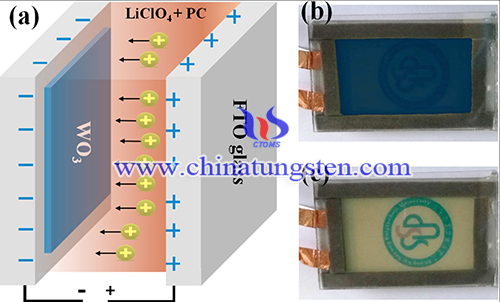Electrochromic Device Based on Tungsten Oxide Prepared From Ammonium Paratungstate
- Details
- Category: Tungsten Information
- Published on Wednesday, 12 May 2021 05:01
Tungsten trioxide (WO3), as a typical transition metal oxide, receives extensive attention because of its great potential applications in chromogenic, gas sensor , photocatalysis and batteries. Electrochromism is the phenomenon that a material can change its optical properties reversible by application of an electric field.
WO3 has been extensively studied as an electrochromic (EC) material due to its excellent coloration effects and is widely used in smart windows, displays and anti-dazzling rear-view mirror. Nanostructured EC films with large specific surface area and porosity are required to achieve fast insertion/extraction kinetics and large ion storage capacity. Thus, electrochromic device based on tungsten oxide had been prepared from ammonium paratungstate.

The tungsten oxide film ((NH4)0.33WO3) was obtained by a typical hydrothermal process as below:
The precursor solution for hydrothermal use was prepared by dissolving 0.3042 g of ammonium paratungstate (APT) and 6.3 g of oxalic acid dehydrate (C2H2O4·2H2O) in 20 g of ethanol. The resulting mixture was sonicated for 15 min before transferred into a 50 mL Teflon-lined stainless-steel autoclave. A piece of FTO glass was placed into the autoclave and leaned on the wall with the conductive side facing down. Then the autoclave was sealed and maintained at 200 °C for 4–8 h. After synthesis, the as-synthesized film was cleaned with ethanol and dried in air; a honeycomb (NH4)0.33WO3 nanoribbon array film was obtained.
The as-prepared (NH4)0.33WO3 film was assembled into EC devices with same configuration of FTO glass/WO3 film/1.0 mol L−1 LiClO4 in propylene carbonate (PC)/FTO glass, and a 0.2 mm-thickness of double sided adhesive tape was used to seal the device.

In summary, (NH4)0.33WO3 nanoribbons films can be successfully fabricated on FTO glasses using a facile hydrothermal method. The morphologies are well preserved. In comparison with the device based on disordered nanoribbons array film, a larger optical modulation (51.6% vs. 39.2% at 700 nm), faster switching speeds (tc/tb, 5.7/4.2 s vs. 9.6/6.5 s) and a higher coloration efficiency (60.9 cm2 C−1 vs. 28.2 cm2 C−1) are achieved for the device based on honeycomb-like structures film.
- APT Manufacturer & Supplier, Chinatungsten Online: ammonium-paratungstate.com
- Tungsten News & Prices of China Tungsten Industry Association: www.ctia.com.cn
- Molybdenum News & Price: news.molybdenum.com.cn
- Tel.: 86 592 5129696; Fax: 86 592 5129797; Email: sales@chinatungsten.com



 sales@chinatungsten.com
sales@chinatungsten.com